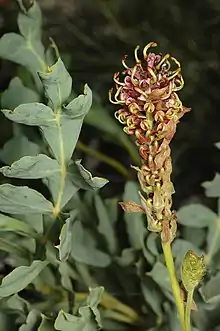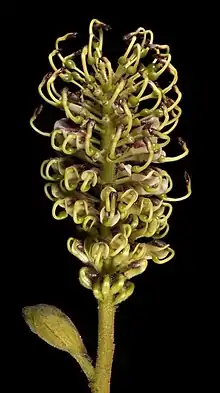Grevillea eryngioides
Grevillea eryngioides, commonly called curly grevillea,[2] is a species of flowering plant in the family Proteaceae and is endemic to the south-west of Western Australia. It is shrub with low clumping foliage with erect flowering spikes, divided leaves with oblong to egg-shaped lobes, and groups of purplish-red flowers with a yellow style.
| Grevillea eryngioides | |
|---|---|
 | |
| In Kings Park, Perth | |
| Scientific classification | |
| Kingdom: | Plantae |
| Clade: | Tracheophytes |
| Clade: | Angiosperms |
| Clade: | Eudicots |
| Order: | Proteales |
| Family: | Proteaceae |
| Genus: | Grevillea |
| Species: | G. eryngioides |
| Binomial name | |
| Grevillea eryngioides | |

Description
Grevillea eryngioides is a glaucous shrub with low, clumping foliage but forms flowering spikes typically 0.5–1.5 m (1 ft 8 in – 4 ft 11 in) high, and that forms suckers. The leaves are mostly 100–180 mm (3.9–7.1 in) long and 30–65 mm (1.2–2.6 in) wide with two to five pairs of oblong to egg-shaped lobes with the narrower end towards the base, the lobes 10–50 mm (0.39–1.97 in) long and 20–30 mm (0.79–1.18 in) wide with wavy edges. Both surfaces of the leaves are glabrous and glaucous. The flowers are arranged on the ends of branchlets or in leaf axils on a long, usually branched flowering spike, in dense, oval groups with many flowers on a rachis 20–70 mm (0.79–2.76 in) long. The flowers are light purplish-red with a yellowish, red- to blackish-tipped style, the pistil 9–11 mm (0.35–0.43 in) long. Flowering mostly occurs from September to November and the fruit is a sticky, oval to lens-shaped follicle 14–21 mm (0.55–0.83 in) long.[2][3]
Taxonomy
Grevillea eryngioides was first formally described in 1870 by George Bentham in Flora Australiensis from specimens collected by James Drummond.[4][5] The specific epithet (eryngioides) means "Eryngium-like".[6]
Distribution and habitat
Curly grevillea gows in heath or shrubland and is widespread between Morawa, Lake Grace, Coolgardie and Peak Charles National Park in the Avon Wheatbelt, Coolgardie, Esperance Plains, Geraldton Sandplains and Mallee biogeographic regions of south-western Western Australia.[2][3]
See also
References
- "Grevillea eryngioides". Australian Plant Census. Retrieved 14 April 2022.
- "Grevillea eryngioides". FloraBase. Western Australian Government Department of Biodiversity, Conservation and Attractions.
- "Grevillea eryngioides". Australian Biological Resources Study, Department of Agriculture, Water and the Environment: Canberra. Retrieved 14 April 2022.
- "Grevillea eryngioides". APNI. Retrieved 14 April 2022.
- Bentham, George (1870). Flora Australiensis. Vol. 5. London: Lovell Reeve & Co. pp. 476–477. Retrieved 15 April 2022.
- Sharr, Francis Aubi; George, Alex (2019). Western Australian Plant Names and Their Meanings (3rd ed.). Kardinya, WA: Four Gables Press. p. 193. ISBN 9780958034180.